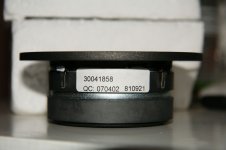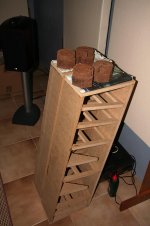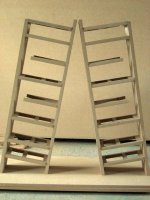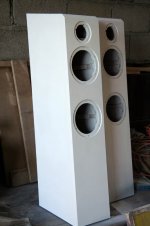Jay_WJ:
You are absolutely right with the "2.25-way" name. "2.75-way" would be good for a speaker where the upper midwoofer has the low end partly attenuated by the means of some sort of a step filter or smaller enclosure limiting its excursion compared to the lower woofer.
However it may not be easy to design the objective experiment you mentioned. The main difference is the vertical response - how to measure which one is better? Blind tests focused on imaging?
You are absolutely right with the "2.25-way" name. "2.75-way" would be good for a speaker where the upper midwoofer has the low end partly attenuated by the means of some sort of a step filter or smaller enclosure limiting its excursion compared to the lower woofer.
However it may not be easy to design the objective experiment you mentioned. The main difference is the vertical response - how to measure which one is better? Blind tests focused on imaging?
Navy_44 said:However it may not be easy to design the objective experiment you mentioned. The main difference is the vertical response - how to measure which one is better? Blind tests focused on imaging?
Vertical lobing is not my concern. We can do a nonlinear distortion test and focus on their midrange performance. It should be easy to perform if one had time, money, and energy.
But my prediction is that difference won't be significant. But let's wait for someone to provide actual results. Or are there any?
Jay_WJ:
The only measurements of midrange distortion at different SPL levels I am aware of are those made by Klang und Ton. In the case of Jordan JX92 the 3rd harmonic is almost identical at 80dB and 90dB (@ 1m). The main difference is the 2nd harmonic being slightly higher and more peaky at 90dB. I would be glad to see a more "pistonic" driver like Seas L18RNX/P measured this way. The peaks of 2nd harmonic (the most significant at 1.8k) at higher SPL in the case of JX92 may come from cone resonances.
There is one more advantage of the TMM arrangement - it is possible to use a 15deg slanted baffle which (acoustically!) lowers the break-up mode of metal cones so it also reduces the peaks of the harmonics associated with the break-up. Another benefit of a slanted baffle is better time-alignment of the acoustic centers, which requires a higher order electrical filter on the tweeter (for a given acoustic order of the x-over), improving the power handling and making a lower XO point possible.
The only measurements of midrange distortion at different SPL levels I am aware of are those made by Klang und Ton. In the case of Jordan JX92 the 3rd harmonic is almost identical at 80dB and 90dB (@ 1m). The main difference is the 2nd harmonic being slightly higher and more peaky at 90dB. I would be glad to see a more "pistonic" driver like Seas L18RNX/P measured this way. The peaks of 2nd harmonic (the most significant at 1.8k) at higher SPL in the case of JX92 may come from cone resonances.
There is one more advantage of the TMM arrangement - it is possible to use a 15deg slanted baffle which (acoustically!) lowers the break-up mode of metal cones so it also reduces the peaks of the harmonics associated with the break-up. Another benefit of a slanted baffle is better time-alignment of the acoustic centers, which requires a higher order electrical filter on the tweeter (for a given acoustic order of the x-over), improving the power handling and making a lower XO point possible.
My main concern about having a mtm 2 way is the difference in time arrival of the sound in the mid., If the listener is slightly vertically off axis from the acoutic center of both woofer. Which result in messing up the sound in the mid , Or would it?
Navy_44 said:The only measurements of midrange distortion at different SPL levels I am aware of are those made by Klang und Ton. In the case of Jordan JX92 the 3rd harmonic is almost identical at 80dB and 90dB (@ 1m). The main difference is the 2nd harmonic being slightly higher and more peaky at 90dB. I would be glad to see a more "pistonic" driver like Seas L18RNX/P measured this way. The peaks of 2nd harmonic (the most significant at 1.8k) at higher SPL in the case of JX92 may come from cone resonances.
I think a better test for this 2 vs 2.5 way issue is a multi-tone test using actual 2 and 2.5-way systems, not a raw driver. The reason is that we want to look at the effect of bass signals on the midrange distortions, considering that bass-mid SPL balance on drivers is different from a 2-way design to a 2.5 way design.
There is one more advantage of the TMM arrangement - it is possible to use a 15deg slanted baffle which (acoustically!) lowers the break-up mode of metal cones so it also reduces the peaks of the harmonics associated with the break-up.
True. But you can do a similar thing with an MTM design although such a baffle is more difficult to build.
Another benefit of a slanted baffle is better time-alignment of the acoustic centers, which requires a higher order electrical filter on the tweeter (for a given acoustic order of the x-over), improving the power handling and making a lower XO point possible.
I understand what you're trying to say. This happens when you turn asymmetric LR4 on a flat baffle into symmetric LR4 on a slanted baffle. But I'd say the effect is minimal. Besides, this change does not always require a higher order slope on the tweeter for better phase tracking, but sometimes needs a higher order slope on the midwoofer.
Here's a really nice article comparing a D'Appolito crossover vs. 2.5 way for an MTM speaker. Very inspiring website as well, definitely inspired me to build a pair of behometh speakers way back when I got into this.
JJ
http://www.speakerbuilding.com/content/1105/index.php
JJ
http://www.speakerbuilding.com/content/1105/index.php
When comparing MTM to TMM, power and polar responses need to be included into the equation. With most arguments for MTM vs. MT, I think the difference lies in power and polar responses.
John K has a nice article:
http://www.musicanddesign.com/Power.html
Regards,
Bill
John K has a nice article:
http://www.musicanddesign.com/Power.html
Regards,
Bill
The one with white paint is positive. But to be sure, check it with a 1.5 v battery. When the connection polarity is in phase, the tweeter's dome comes forward.
Jay_WJ said:The one with white paint is positive. But to be sure, check it with a 1.5 v battery. When the connection polarity is in phase, the tweeter's dome comes forward.
Thanks! 🙂
Just an update.
I could only do this project on sundays, so my progress is slow. This is the 3rd week since I started cutting the MDF. So far, I managed to build and assemble the front, back, top, bottom and braces together.
I dont have a table saw , But I made the panels and braces straight, square and aligned by using my DIYed straight guides for my circular saw. Which I made before cutting any mdf to be used for the project.
The design is a TMM with about 1.2 cf. box, bessel alignment. The box is slanted by 10 degrees. The front panel is double thickness, The MDF is 18mm thick.
As of this writting , The glue is still curing on the bottom panel. I moved the box into my listening room , because my "make do" workshop is'nt totally wheather proof and the wheather is not good right now. SO my listening room looks kinda messy now. But of caorse no cutting and routing were done in the listening room. Just gluing and clamping.
Below is a picture of the progress I made so far.
I could only do this project on sundays, so my progress is slow. This is the 3rd week since I started cutting the MDF. So far, I managed to build and assemble the front, back, top, bottom and braces together.
I dont have a table saw , But I made the panels and braces straight, square and aligned by using my DIYed straight guides for my circular saw. Which I made before cutting any mdf to be used for the project.
The design is a TMM with about 1.2 cf. box, bessel alignment. The box is slanted by 10 degrees. The front panel is double thickness, The MDF is 18mm thick.
As of this writting , The glue is still curing on the bottom panel. I moved the box into my listening room , because my "make do" workshop is'nt totally wheather proof and the wheather is not good right now. SO my listening room looks kinda messy now. But of caorse no cutting and routing were done in the listening room. Just gluing and clamping.
Below is a picture of the progress I made so far.
Attachments
Dear all,
I just want to give an update to those who are interested in this project.
I already finished building the box , The build was easier than I first thought, I now just begun to prime the box after 2 coats of diluted wood glue applied on the box.
As of this writing , I already applied 3 coats of primer using HVLP spray gun, But the glue lines and the MDF edges' texture are still visible.
I'm no expert in finishing speaker box, and I suck in painting speaker box. Veneer is not an option for me, Because I I havent seen a veneer that I like in my local stores, And I dont know where and If I can order wood veneer online.
Can anybody give me a tip on what I should do next, on finishing the speaker? After the 3 coats of primer paints
I'm not going to make the finish piano gloss perfect, cause I know that is very difficult to do.
Will acrylic spray paint cans good enough as top coat on the finish?
BTW, I'm using a white flatwall enamel paint as a primer.
Thanks
Below is the photo of the speaker.
I just want to give an update to those who are interested in this project.
I already finished building the box , The build was easier than I first thought, I now just begun to prime the box after 2 coats of diluted wood glue applied on the box.
As of this writing , I already applied 3 coats of primer using HVLP spray gun, But the glue lines and the MDF edges' texture are still visible.
I'm no expert in finishing speaker box, and I suck in painting speaker box. Veneer is not an option for me, Because I I havent seen a veneer that I like in my local stores, And I dont know where and If I can order wood veneer online.
Can anybody give me a tip on what I should do next, on finishing the speaker? After the 3 coats of primer paints
I'm not going to make the finish piano gloss perfect, cause I know that is very difficult to do.
Will acrylic spray paint cans good enough as top coat on the finish?
BTW, I'm using a white flatwall enamel paint as a primer.
Thanks
Below is the photo of the speaker.
Attachments
Nice crossover layout, marchel! Cabinets look great, too.
Foil inductors are for the .8 mH ones in series with the woofers, aren't they? BTW, do you use the exact xover design I modeled for you?
Foil inductors are for the .8 mH ones in series with the woofers, aren't they? BTW, do you use the exact xover design I modeled for you?
marchel said:Another photo, The assembled XO.
Just curious how much did you pay for the parts for x-over alone?
Piano gloss finish is achieved somewhat similar to the high gloss car paint. On the factories it is done with Polyester or Ceroglaze post catalyzed finish and unless you are fully equipped to do it don’t even look in that direction. We talking about air fed respirator and special buffing compounds.
Any wood finish (not including penetrating oils), given a high enough build up can be polished to a very high gloss. Lacquer, polyurethane or varnish. See what’s available in the local store. The smother the final application, easier the next step.
The next step after build up.
Sanding the finish perfectly flat. If you manage to get it run-free and relatively dust free, start with 600 wet-dry sandpaper. Sand it with a hard rubber block and use water as a lubricant. If the sanding done properly, you should see no reflection on the finish.
After a few hours of this fun, you could switch to 800 grit wet-dry sandpaper, then 1500.
After that, go to the auto body store and purchase 3M compounds. If you explain the purpose to the knowledgeable salesman, they will give you correct grades.
If you don’t own a buffer, rub it with compound on a cheese close like you’ve never rubbed before.
Using flat wall enamel as a primer is not a good idea for this purpose. It may cause adhesion problems later on.
Lat me know, what wood finishes are accessible for you and I will be able to advise in more detail.
Any wood finish (not including penetrating oils), given a high enough build up can be polished to a very high gloss. Lacquer, polyurethane or varnish. See what’s available in the local store. The smother the final application, easier the next step.
The next step after build up.
Sanding the finish perfectly flat. If you manage to get it run-free and relatively dust free, start with 600 wet-dry sandpaper. Sand it with a hard rubber block and use water as a lubricant. If the sanding done properly, you should see no reflection on the finish.
After a few hours of this fun, you could switch to 800 grit wet-dry sandpaper, then 1500.
After that, go to the auto body store and purchase 3M compounds. If you explain the purpose to the knowledgeable salesman, they will give you correct grades.
If you don’t own a buffer, rub it with compound on a cheese close like you’ve never rubbed before.
Using flat wall enamel as a primer is not a good idea for this purpose. It may cause adhesion problems later on.
Lat me know, what wood finishes are accessible for you and I will be able to advise in more detail.
Thanks Jay,
Yup, the foil inductors are for the upper woofer, The 3mh. metal laminate coil wer'ent included in the picture.
The internal of the box lacked space for the XO assembly, due to the extensive bracing I employed, So I elected to locate the XO outside the box, in their own enclosure. Only the 3mh. coil for the lower woofer will be located inside the box. It would have been possible to mount the XO inside the box in 3 or 4 separate section, But the thought of wiring and mounting all of them inside discouraged me to do so.
Jay, The XO have minor deviation from your design. The Foil inductor is .82mh instead of .8mh, cause there is no .8mh available .
I use 9mf. cap instead of 10mf cap on the tweeter, Cause I figure out that it is easy to add a parallel caps to increase the value , If it turns out that the sound are not optimal. I also use 1.5ohm in place of 2ohm for the tweeter. cause Madisound currently dont have 2ohm in stock.
Inspite of the changes I made , They still have good FR and phase tracking on the simulation software.
Hello ttan98,
I think I've spent almost 400usd on the XO parts including the ports and the terminals.
Thank you R-carpenter,
I will look at my local store to see what is available, But I could remeber that they have 2 part epoxy paint for marine use.
Should I strip the flatwall paint to avoid any problems later?
Thanks
Yup, the foil inductors are for the upper woofer, The 3mh. metal laminate coil wer'ent included in the picture.
The internal of the box lacked space for the XO assembly, due to the extensive bracing I employed, So I elected to locate the XO outside the box, in their own enclosure. Only the 3mh. coil for the lower woofer will be located inside the box. It would have been possible to mount the XO inside the box in 3 or 4 separate section, But the thought of wiring and mounting all of them inside discouraged me to do so.
Jay, The XO have minor deviation from your design. The Foil inductor is .82mh instead of .8mh, cause there is no .8mh available .
I use 9mf. cap instead of 10mf cap on the tweeter, Cause I figure out that it is easy to add a parallel caps to increase the value , If it turns out that the sound are not optimal. I also use 1.5ohm in place of 2ohm for the tweeter. cause Madisound currently dont have 2ohm in stock.
Inspite of the changes I made , They still have good FR and phase tracking on the simulation software.
Hello ttan98,
I think I've spent almost 400usd on the XO parts including the ports and the terminals.
Thank you R-carpenter,
I will look at my local store to see what is available, But I could remeber that they have 2 part epoxy paint for marine use.
Should I strip the flatwall paint to avoid any problems later?
Thanks
Don’t strip anything yet. See what’s available in the store. You should probably pay a visit to a local woodworking-finishing supplier. Are you capable to spray flammable finishes? Are waterborne wood finishes available locally or through mail-order?
marchel said:I use 9mf. cap instead of 10mf cap on the tweeter, Cause I figure out that it is easy to add a parallel caps to increase the value , If it turns out that the sound are not optimal. I also use 1.5ohm in place of 2ohm for the tweeter. cause Madisound currently dont have 2ohm in stock.
Yes, it's a good idea to try different values for the primary capacitance later. To adjust the overall tweeter level, you have two options---change the series or the shunt resistance. They result in a little different response shaping---check it out using simulation. You may want to tilt down the treble depending on your taste. To my ear the HDS tweeter tend to sound strong.
- Home
- Loudspeakers
- Multi-Way
- MTM vs TMM, 2 WAY vs 2.5WAY sound quality question.




